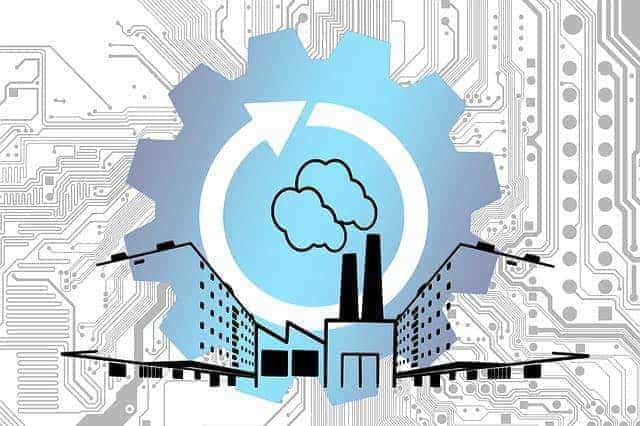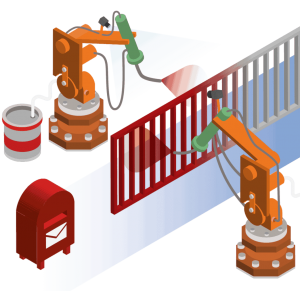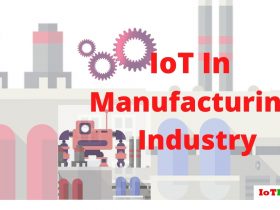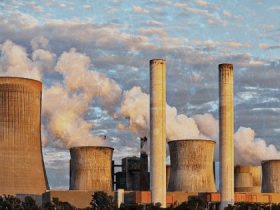What is Industry 4.0
Fourth Industrial Revolution
The Internet of Things (IoT) & Industry 4.0 names for related concepts. These concepts do not have precise definitions. A very useful definition of IoT was offered by Bryce Barnes, Senior Manager of the machine and robot system at CISCO Systems.
Mr. Barnes explained IoT, as the intelligent connectivity of smart devices by which objects can sense one another & can communicate and this shows that how, where and by whom the changes are made in our physical world.


Image credit: Geralt/Pixabay
Industry 1.0 was the invention of mechanical help, Industry 2.0 was mass production, Industry 3.0 brought element systems to the shop floor & Industry 4.0 is peer-to-peer communication between products, systems & machines. The emerging Industrial IoT gave rise to the prediction of the change which will configure the industry. Industry 4.0 is the sign of the future for India as a spot as the “Digital Factory of the World”.
Industry 4.0 has few principles as it is a meeting of real and virtual worlds in manufacturing and involves the full integration of manufacturing technologies and systems to make a “SMART FACTORY”.
See also: Network Edge boosting ladder to the IIoT World
The smart factory is a highly flexible manufacturing setup that is digitally interlinked with every aspect of the manufacturing ecosystem from suppliers to customers. The shop floor of a smart factory consists of intelligent, networked machines that operate autonomously to achieve mass customization of intelligent, networked products.
Another basic principle is the essence of IoT and smart manufacturing. A smart manufacturing organization which consists of four elements: informed products, processes, people and infrastructure. The development & adoption of IoT is a critical element of smarter manufacturing. According to a HIS Technology report, industrial automation accounted for more than half of the base for all interconnected devices in 2012.


Image credit: geralt/Pixabay
“By 2025, the sector will account for nearly ¾ of all connected devices… a compound annual growth rate of 36.3%.” The opportunity is humungous, needless to say. The Industrial Internet of Things is the next wave of innovation, impacting the way of connecting the world & optimizing the machines.
The Industrial IoT is connecting the physical world of sensors, devices & machines with the internet & the massive data into powerful insights & intelligence.
Today we have only 1% of world devices connected. This means that the wealth of information that is generated in them gets dropped on the floor without any corporate systems mining them for insights. Getting devices connected can open huge no.of opportunities for improving operational efficiency, customer care, and insights.
See also: Benefits of IIoT – its challenges and Future scope
Making S-E-N-S-E of Internet of Things
Key attributes of IoT & how it differs from “regular internet.”
| S-E-N-S-E | What the Internet of Things does | How it differs from the Internet |
|---|---|---|
| Sensing | Leverages sensors attached to things (e.g. temperature, pressure, acceleration) | More data is generated by things within sensors than by people |
| Efficient | Adds intelligence to manual processes (e.g. reduce power usage on hot days) | Extends the internet’s productivity gains to things not just people |
| Networked | Connects objects to the network (e.g. thermostats, cars, watches) | Some of the intelligence shifts from the cloud to the network’s edge (“fog” computing) |
| Specialized | Customizes technology and process to specific verticals (e.g. healthcare, retail, oil) | Unlike the broad horizontal reach of PCs and smartphones, the IoT is very fragmented |
| Everywhere | Delayed pervasively (e.g. on the human body, in cars, homes, cities, factories) | Ubiquitous presence resulting in an order of magnitude more devices and even greater security concerns |
Most of the industrial automation system was designed with an expectation of isolation from external networks. Thus each of these systems will have to be re-designed or made IoT ready, so they address the key challenge of getting the systems connected. The next challenge will include in being more adept to manage & analyze operational data on the machine, on-premise & in the cloud. The analytics platform will finally optimize operations.
Thus existing industrial devices which were designed to be stand-alone or to only be connected to proprietary, on-premise networks will be modified to connect to the internet. These new industrial devices will be made IoT ready which will clear the benefits of decreased service host through predictive maintenance & remote management. However, both these devices have to address the challenges of secure connectivity to ensure that these systems can withstand the inevitable network-born attacks that will target them.
Industrial IoT thus enables data and information available and can be accessed from any device or any remote location. This will drive the efficiency of operations for companies with a global presence. In future the automation systems will use data to self-configure, self-regulate & suggest efficiency improvements. In the last couple of months, our PM Mr. Narendra Modi going the extra mile for attracting global investment with Make in India program.
This has sparked a great deal of interest and we see a lot of excitement in the industry in launching initiatives to help advance this program. Altizon system believes that Industrial IoT will drive the next innovation wave in manufacturing and will be an incentive for the Make in India.
Looking for a new pair of pants? Right now you’re likely to go to a store or order a pair online in a standardized size, typically one of four variants ranging from S to XL.


Image credit: Baslerweb
Low unit costs are achieved through mass production. It’s time to change the way of shopping with IoT.
Image processing the most important component of Industry 4.0. Textile production in the world of Industry 4.0 may instead deliver customized individual pieces by taking advantage of efficient data processing. Once a customer decides on a model, their dimensions could be determined via Image processing system (machine vision system).
In this machine, the system takes the form of a small changing room with 4 cameras to take pictures of each side of the body. This system has software which handles the measurements and the subsequence cutting pattern for production. The remainder of production runs automatically right up through shipping.
Fashion houses of the future will thus no longer sell their services based around full achieves with huge offerings, but rather through a large virtual selection and quick, reliable production. Image processing systems are an essential component of automated production, from the inspection of raw materials and production monitoring (i.e. flaw detection) to final inspections and quality assurance, this is an indispensable part of achieving high efficiency and quality standards.
See also: Industrial Internet Things || Industrial IoT Brief Overview
The term Industry 4.0 is defined as a new process, forms, and organization of industrial production. The core element of Industry 4.0 is networking and extensive data communication. The goal is self-organized, more strongly customized and efficient production based on comprehensive data collection and efficient exchange of information.
Image processing plays a decisive role here in determining specific information. One important point is that cameras continue to grow smaller and more affordable even as performance improves. One important effect of Industry 4.0 is the fact that due to using of controlled automation many workpieces can be produced cost-effectively not just in large quantities, but also in much smaller lots.
But how can precise industrial camera system support in this effort?


Image credit: Baslerweb
At the same time, the painting results can also be controlled optically, either through assessment of coloring or by measuring more complex reflective properties of the coating. This control data can flow in real-time into the control unit. As such, a system for automated coating can become a self-learning system. New but similar components could then be processed more efficiently based on the prior experience.
Cameras as Tireless Process Auditors
Sensor data helps in early detection or even flawed device behavior of machines which lead to automated countermeasures (such as changes to process parameters or ordering of replacement materials and/or service calls) for both production equipment as well as for the finished products.
These cameras play a significant role in this process which offers a tireless method for auditing the color, structural and geometric properties of even large workpieces and products for correctness or deviation. ‘Soft’ factors such as lubrication, wear and rusting can also be taken into account providing data for a company’s enterprise resource planning systems. Production employee will also benefit from the application using industrial cameras. However far automation progresses, there are good reasons why there will always be a place for humans in industrial production.


Image credit: skeeze/Pixabay
In future workflows will also change. Human efficiency has also enhanced through intelligent machine vision systems integrated into helmets, garments, and tools. This is fully technically feasible, as cameras continue to grow smaller and lighter: high-precision industrial cameras, weighing less than 30g including lens & casing are already available today.
The vision systems record the activity and work status visually, audit the results, identify sensible steps and forward it to humans.
For example as notifications on Smart Glasses working with augmented reality.
See also: How is IoT optimizing Costs for Industrial Sectors?
Let us know what you think about Industry 4 .0 in the comment section below.
If you like this post subscribe our YouTube Channel for IoT video Tutorials. You can also find us on Twitter, Facebook, and Instagram for more updates.
References:
- https://www.cisco.com/
- http://www.industrial-ip.org/en/industrial-ip/internet-of-things/ip-technology-is-the-future-for-industrial-automation
- http://www.makeinindia.com/home
- https://en.wikipedia.org/wiki/Digital_image_processing
- https://en.wikipedia.org/wiki/Smartglasses
Featured Image credit : geralt/Pixabay














1 Review